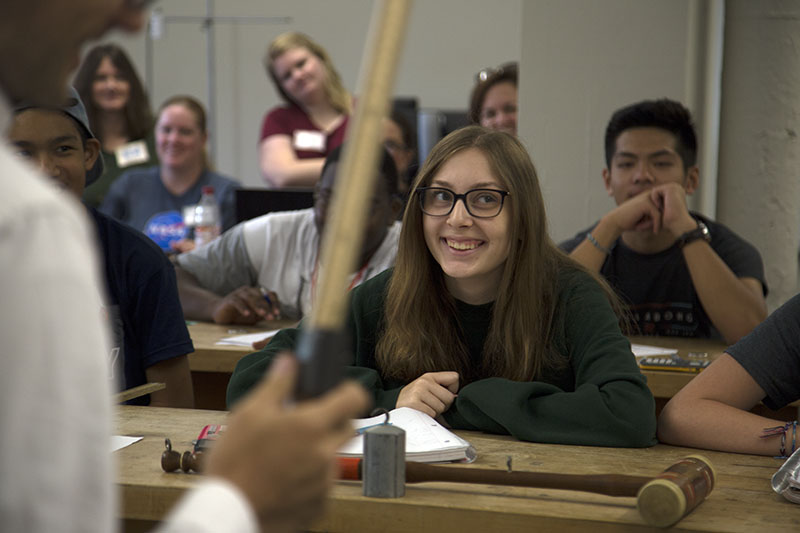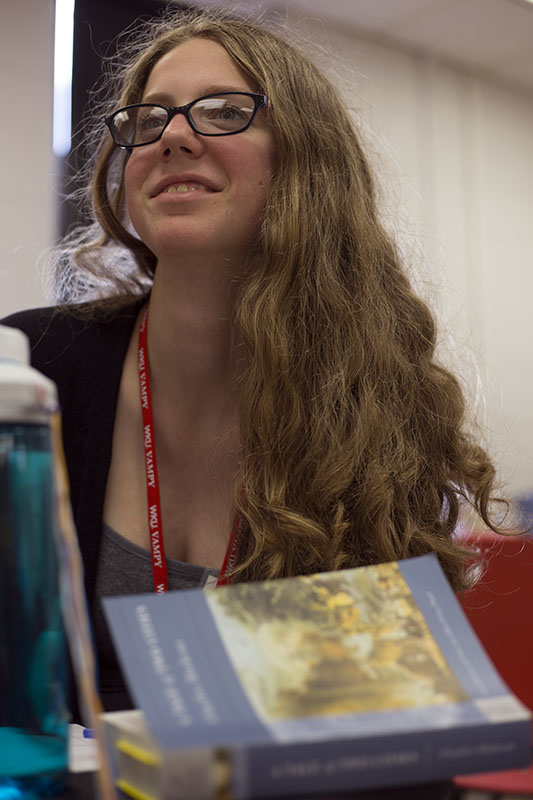
by Erika Solberg
At VAMPY, the last days of class are still full of opportunities to discover as well as chances for students to demonstrate what they have learned. Here’s a quick peek at was going on in some of our classes on Wednesday and Thursday:
POP CULTURE
On Wednesday afternoon, Pop Culture was in the quarterfinals of its Pop Madness Debate Tournament, as students argued what object, event, person, or innovation has most influenced pop culture. Pairs of students went head to head in a formal debate structure, giving opening positions, rebuttals, and final rebuttals. After, the opponents went into the hallway while the class discussed the quality of the arguments and voted a the winner through secret ballot.
In one debate, Nolan Beasley argued for Facebook and Brock Kessinger for the internet. Nolan asserted, “It’s not necessarily what hosts the media that makes it influential, but what the actual media is.”
Brock responded, “Because the Internet was the progenitor of Facebook and all these other sites and entire cultures, it is the most influential thing in pop culture.”

Next up was Rosie the Riveter versus Saturday Night Live. Among other points, Josie Cooley asserted that Rosie inspired many changes in women’s clothing. Brody Johnson stressed that SNL satire has influenced American politics for almost 40 years.
During the discussion of the debate, classmates raised such points as the failure of a debater to address a factual error, the improvement of one of the debater’s initial statement, and the strength of some of the rebuttal arguments.
After all the students in the second round had made their cases and all votes were tallied, the final four was announced: Muhammad Ali vs space exploration, and the internet vs SNL.
Meanwhile, students were finishing up art projects, both individual and group. Wyleigh Watson had an impressive Marvel painting she had created using a stencil she had cut out herself. Piper Poteet, Hollis Maxon, and Addie Blankinship worked on a large mural that featured 20 LP records; paintings of Elvis Presley, Tupac Shakur, Michael Jackson, and Dolly Parton; and an Aretha Franklin quotation: “Music changes, and I’m gonna change right along with it.”

COMPUTER SCIENCE
Students in Matt Stagg’s computer science class were working with Lego robots. Teammates Anastasia Gukasova and Ari Chen filled us in on Wednesday:
Anastasia: We have made Lego EV3 robots and are programming them to do a series of challenges. We get points based on the challenges we do successfully. In one of our programs, our robot is supposed to go forward, push a bar down, turn and go forward a bit more, and pick something up so it rolls down a hill. That’s what we’ve been working on yesterday and today — today has been lot of tweaking.”
Ari: The way this coding software works is you drag blocks from the bottom of the screen and join them together at the top, and there are a few different selections. In our robot, we have two large motors, which are the wheels, and one small motor, which is the car. This first code block means the motors will move the wheels at 50% speed for six full rotations. This second block is a steering block which turns the robot 30 degrees left.”
ASTRONOMY
On Thursday, teacher Ashley Murphy, who teaches high school physics and astronomy at Greenwood High School, gave us the run-down on the last days of class: “On Wednesday night, we attempted to look at the moon using the PVC telescopes the students had made during week one. The moon has not been in phase to see all camp, so even though it was cloudy, we went out by the colonnade and tried to catch the moon between the clouds. Today, we talked about relativity as well as black holes.
“Tomorrow we will discuss cosmology, which is studying galaxies. We will follow Hubble’s line of reasoning to find out that each galaxy is moving away from all the other galaxies — thus, the Big Bang. We will have a rubber band activity and talk about the expanding universe and pull in some classic stories about a two dimensional universe and imagine that world to help us conceptualize the idea of the universe having four or even more dimensions. The subject matter gets very deep, and we’ll try to goes to some really far out places.”
PHYSICS
On Thursday, the class was studying optics. Teacher Kenny Lee had gone over the mirror equation, which involves the focal length, the distance to object, and the distance to image. He then gave students this problem: “A concave mirror has a center of curvature of 20 cm. A 5 cm-tall object is placed 30 cm in front of the mirror. Locate the image and its height.”
Working at the white board, Kenny talked through the steps of plugging the known data into the equation and then worked the equation so the unknown was on the right side. Then he said, “I’ll pause there for a moment to add dramatic effect.” When he was ready, he went on: “You have your small microcomputers that we call calculators, so you have a multitude of ways to do this calculation. I want to show you the way that I think works best for pretty much any type of calculator, even the world’s finest calculator, Mr. Lee’s. [Note: Mr. Lee’s calculator is the lowest-tech device in the classroom.]
Why would anyone need to use the mirror equation or its sibling, the magnification equation? Glasses-wearer Izaiah Exum gave one vital explanation: “If you’re a person who makes lenses for eyeglasses, it’s important to know where the focal point should be, so that when someone who has an astigmatism puts the glasses on, the focal point will be in the right place.”

REVOLUTIONS
Part of Thursday morning was spent with the class gathered in a circle taking turns reading aloud from the chapter The Substance of the Shadow from A Tale of Two Cities. With the novel drawing towards its climax, the students were eager to follow along with the next plot twist. Teacher Jan Lanham had lost her voice but still managed to rasp out explications and draw attention to key points, such as the line, “I mark this cross of blood upon him as a sign.”
The afternoon would be spent with students finishing up assignments on the three revolutions they have been studying, the American, the French, and the Russian. Their work included timelines and Who’s Who projects that explained important events and historical figures, descriptions of the daily lives of people from the studied time periods, and tests. By this point of the course, student work hung on every wall — completed timelines and Who’s Who projects, posterboards covered in post-it notes, drawings, and more.
HUMANITIES
On Wednesday, the class spent part of the afternoon conducting a Socratic circle on Paradise Lost. The students respectfully listened to each other as they answered questions posed by their teacher Tracy Inman. One question was, “How is this work a reflection of late 17th-century life in England?” Some excerpts from the discussion follow:
Abby Adams-Smith: There’s a lot of misogyny. The proof comes in book 10 — the whole exchange between Adam and Eve is a cesspool of misogynistic ideas. The section that says Adam is betraying one lord and Eve is betraying two — there’s a lot to unpack in there.
Taylor Galavotti: The ideas of predestination and free will are there throughout the book. God knows what’s going to happen, and then he sends an archangel to tell Adam and Eve what’s going to happen, and those were ideas that circulated in 17th-century England. I don’t think we’ve seen them in any of the other epic texts we’ve studied.
Taylor’s comment leads to an animated debate about foreknowledge, predestination, and free will. Here are some of the points made:
Abigail Portmann: Pre-knowledge is knowing what will happen beforehand, while predestination is, “This is going to happen no matter what.” With pre-knowledge, you have free will. With predestination, God is making things happen.”
TA Ryan Hiles: If God knows what’s going to happen, and God is the only one who can fix it or change it in any way, and God knows that he’s the only one who can, how is that not effectively predestination?
Eric Eastman: If I came in and started whaling on Bradfield, is that God’s fault? No, that’s mine. I made that choice. God did not prevent it, but that doesn’t mean he did it.
Eventually, Tracy told the class with a smile, “Look at the question again.” Seeing how far they had gotten off track, the students laughed. There was still plenty of time to keep talking.
